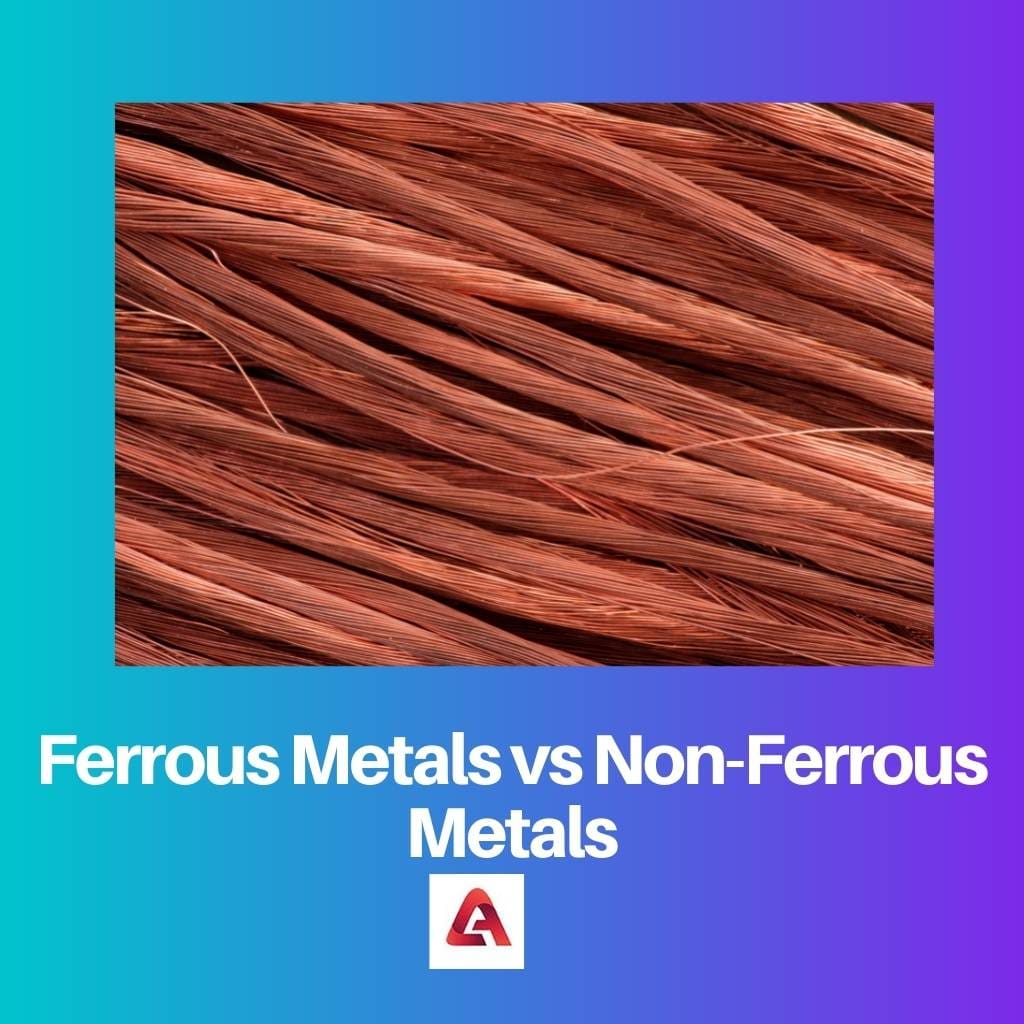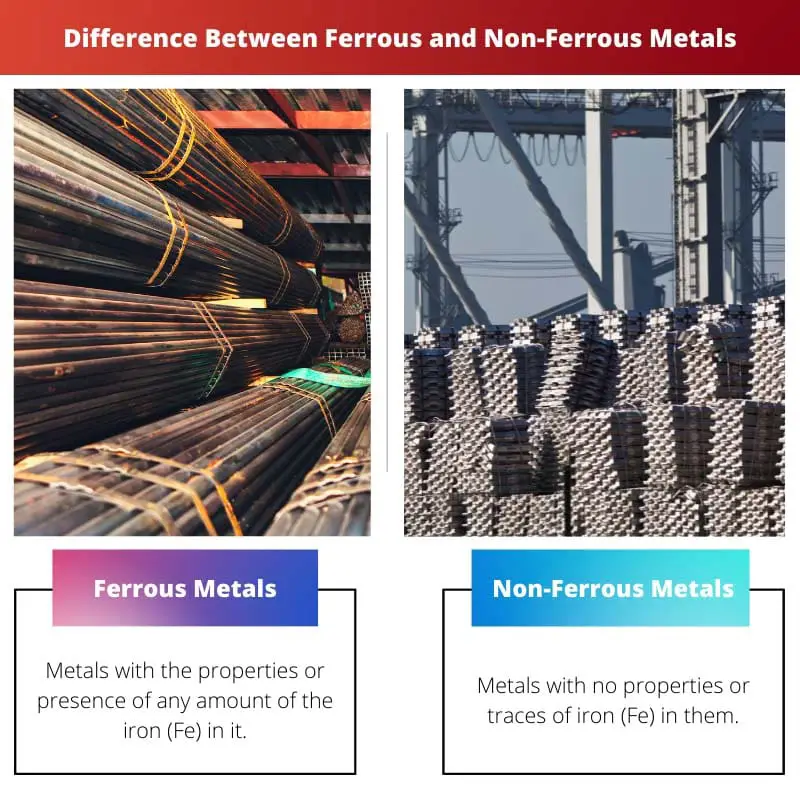In mother nature, many types of metals are found that are known to us, and many of them might be unknown, unidentified, and not even yet discovered.
The properties of these metals are similar and may be different from each other. The study of these elements and their properties by chemists is known as metallurgy.
Key Takeaways
- Ferrous metals, such as steel and cast iron, contain iron and are magnetic.
- Non-ferrous metals do not contain iron and are non-magnetic, like aluminum, copper, and brass.
- Ferrous metals are prone to rust and corrosion, while non-ferrous metals resist corrosion better.
Ferrous Metals vs Non-Ferrous Metals
The difference between Ferrous metals and Non-ferrous metals is that ferrous metals are defined as metals with the properties of any amount of iron (Fe) in their chemical structure. They also persist in many magnetic properties along with a high risk of corrosion. Whereas comparatively, on the other side, non-ferrous metals are metals with no or less amount or properties of iron in them. They also do not persist in any magnetic properties and don’t have any risk of corrosion.

Ferrous Metals, in simple terms, are defined as metals having the properties of iron or the presence of iron in their chemical structure.
The origin of the word ferrous is from the Latin word ‘ferrum,’ and the meaning for the same is ‘iron containing.’ The presence of iron metal provides the magnetic property within the ferrous metals.
Non-Ferrous Metals, in simple terms, can be defined as metals that do not have the properties of iron or any minute presence of iron or its components in their chemical structure.
Some of the best examples of non-ferrous metals that have been in use since civilization are – Zinc, copper, aluminium, nickel, lead, tin, and many other examples.
Comparison Table
| Parameters of Comparison | Ferrous Metals | Non-Ferrous Metals |
|---|---|---|
| What is it? | Metals with the properties or presence of any amount of the iron (Fe) in it | Metals with no properties or traces of iron (Fe) in them |
| Magnetic Property | They show high magnetic property | They show less or no magnetic property |
| Tensile Strength | Shows high tensile strength | Low tensile strength |
| Advantage or Usage | Used for the strength purpose and no use of magnetic property | Used in the appliances related to electricity |
| Corrosion | High risk | Low risk |
| Examples | Steel, cast iron, pig iron, etc | Zinc, cobalt, aluminum, etc |
What are Ferrous Metals?
In simple terms, they are defined as the metals persisting the traces of iron or its components. They have the properties of iron (Fe) in them, thus leading to the magnetic property of the metals.
The metals tend to show high tensile strength because of their capacity to carry high strain.
These metals have a high intensity of risk for getting corrode. This is because of the presence of iron (Fe) properties or its traces in the metals.
They react with the air, and because of it, the oxide layer of reddish-brown color starts depositing on the surface.
Ferrous metals are used in construction works and for strength purposes. They are doped with other metals to make an alloy like – copper + steel, nickel + steel, and many more.
Examples of ferrous metals are – cast iron, wrought iron, carbon steel, alloy steel, and many others.

What are Non-Ferrous Metals?
In simple terms, non-ferrous metals are defined as metals having no traces of iron or its components in their chemical structure.
As non-ferrous metals do not contain any traces of iron or its components or properties, they also lack magnetic properties in the metals. The metals tend to show tensile strength, but it is very low.
Non-ferrous metals don’t have iron or its properties, which is why they are less prone to the process of corrosion.
The advantage of non-ferrous metals is that they are very light in weight and are most malleable. The market value of these metals is quite high compared to that of ferrous metals.
Examples of non-ferrous metals are – copper, aluminium, zinc, nickel, lead, tin, gold, silver, platinum, palladium, and many more. Aluminium metal is used in making auto parts for many appliances.
Copper is best suited for making bearings, pipes, etc. Zinc metal is used as the surface coating for iron and steel to prevent rusting.

Main Differences Between Ferrous and Non-Ferrous Metals
- Ferrous metals are those metals having or persisting the properties of iron or its components. Also, they might have traces of iron in their chemical structure. While comparatively, on the other side, non-ferrous metals are those metals that do not persist in any amount or properties of iron in their chemical structure.
- Ferrous metals show the presence of some magnetic properties because of the presence of iron. While comparatively, on the other hand, the non-ferrous metals are the ones with no iron in them, thus with no magnetic properties in them.
- The tensile strength of ferrous metals is quite high because of their high capacity to carry high strain, whereas comparatively, on the other side, the tensile strength of non-ferrous metals is quite low.
- Ferrous metals are widely-used when there is strength purpose demand instead of the magnetic one (in simple terms – magnetic properties required should be poor) whereas comparatively, on the other hand, non-ferrous metals have been widely used for appliances that are related to electricity.
- The presence of iron in the ferrous metals made the metals a very risk factor for corrosion as the metals get oxidized in the air and form the reddish-brown layer or the oxide layer known as rust on the upper surface. Whereas comparatively, on the other side, non-ferrous metals have a low risk of getting corroded or, say, they have high resistance from the process of corrosion.
- Examples of ferrous metals are – steel, cast iron, pig iron, etc., whereas comparatively, on the other hand, the examples of non-ferrous metals are – aluminum, zinc, copper, etc.

- https://link.springer.com/article/10.1007/s11665-002-0014-2
- https://www.sciencedirect.com/science/article/abs/pii/S0167732217342137
- https://www.sciencedirect.com/science/article/abs/pii/S1003632617601729
- https://www.sciencedirect.com/science/article/pii/S2214785317329620

I appreciate the detailed descriptions of ferrous and non-ferrous metals. The examples provided also help in understanding their practical applications.
The detailed descriptions of the properties and advantages of ferrous and non-ferrous metals are extremely valuable. I thoroughly enjoyed reading this article.
I appreciate the clarity of the explanations. It’s a great reference for anyone studying or working with metals.
I couldn’t agree more. The practical examples and comparisons make it easy to understand.
I agree, the examples of ferrous and non-ferrous metals make it easier to grasp the concepts discussed in the article.
I never knew there were such fundamental differences between ferrous and non-ferrous metals! This article was very enlightening.
Indeed, the article provides an excellent explanation of these concepts.
I agree, understanding the differences in properties and uses of these metals is crucial for various industries.
This article provides a comprehensive overview of ferrous and non-ferrous metals. It’s fascinating to learn about their properties and applications.
Absolutely, the comparison table is especially helpful in illustrating the distinctions between the two types of metals.
I found the section on corrosion particularly interesting. It’s essential information for anyone working with metals.
The article effectively highlights the differences between ferrous and non-ferrous metals, providing valuable insights into their properties and applications.
I found the section on the advantages and uses of non-ferrous metals particularly informative. It’s essential information for various industries.
Absolutely, it’s an excellent resource for anyone seeking to understand the distinctions between these metals.
This article offers a clear and concise explanation of the properties and characteristics of both ferrous and non-ferrous metals.
Agreed, it’s an excellent resource for students and professionals in the field of materials science.
The section on the differences in magnetic properties between the two types of metals is particularly insightful.
I found that aspect quite intriguing as well. It’s interesting how the presence of iron impacts the magnetic behavior of metals.
Yes, understanding the magnetic properties is crucial, especially in industrial and engineering applications.
The comparison table is very helpful in summarizing the key differences between ferrous and non-ferrous metals.
I never realized the extent of the differences in properties and applications between the two types of metals. This article provided valuable insights.